Accurate, medium-range weather forecasting information can help mitigate smallholder farmers’ exposure to climate-related risks. PxD is in the process of launching new products to assist smallholder farmers to make more informed and timely decisions based on weather information. In this post, we outline the contours of our exploratory research to integrate weather forecasts into Coffee Krishi Taranga (CKT), our existing digital advisory service for small coffee farmers in India.
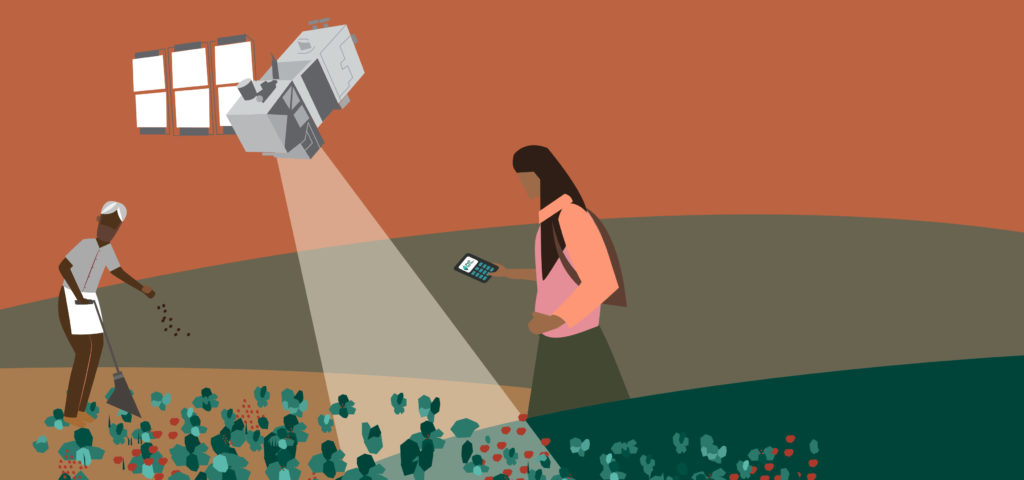
Coffee is a notoriously fickle crop. For example, heavy rainfall can damage crops, result in premature fruit-drop, increase the incidence of pests, and wash away fertilizer with negative implications for plant nutrient levels. Increasing weather variability and the incidence of extreme weather events associated with climate change will have significant negative effects on coffee producers. Given the sensitivity of the crop — and yields — to fluctuations in the weather, coffee farmers are likely to derive meaningful benefits from accurate and timely weather forecasts. Insights from our CKT learning agenda will be used to inform the design of a larger evaluation of the weather-integrated service and to scale an enhanced service to over 150,000 coffee farmers across four Indian states (Karnataka, Kerala, Tamil Nadu, and Andhra Pradesh – an expansion state).
The motivation
PxD delivers CKT in partnership with the Coffee Board of India and with support from the Walmart Foundation. Since 2018, CKT has delivered a two-way interactive voice response (IVR) service with two principal components: an outgoing push call service that provides regular advisory to coffee growers via their mobile phones, and an inbound hotline that farmers can call to access free information services. In April 2022, CKT reached just over 70,000 smallholder coffee farmers in Karnataka, Kerala, and Tamil Nadu.
More accurate information about medium-term rainfall — with a lead time of up to 15 days — will enable farmers to make informed decisions about applying nitrogen fertilizer and increase the likelihood that they apply this input during dry spells to reduce run-off and leaching. Similarly, if farmers are alerted to impending heavy rain, they can leverage this information to alter harvesting times or take other precautionary measures to protect crops and insulate yields.
Speaking to farmers to inform design and process
In interviews conducted with coffee growers in August 20211 Described further in an earlier blog post that outlined findings from the landscape analysis of coffee production in Karnataka and Andhra Pradesh relating to sustainability, market linkages, and gender., only 16% of respondents reported accessing forecasts (N=73). Integrating weather information into CKT’s existing services will broadcast weather forecasts to farmers tailored to their specific contexts and complement these forecasts with agronomist-designed advice. Exploratory and pilot research will be implemented between May and December 2022 in three important coffee-growing districts in Karnataka: Chikmagalur, Hassan, and Kodagu.
Studies conducted in other contexts find that farmers form subjective expectations about upcoming weather events based on various factors, including their past experiences, local rules of thumb, existing forecast information, the costs and benefits of acquiring such information, and perceptions about how relevant weather-related risk is to their incomes2As demonstrated in Giné, X., Townsend, R.M., & Vickery, J. (2015). “Forecasting When it Matters: Evidence from Semi-Arid India.” Working Paper.. These expectations inform behavior over the course of the coffee crop cycle as farmers make decisions relating to input and investment choices, the timing of activities, and so on. The sum of these decisions, in turn, influences outcomes that farmers (as well as researchers and practitioners) are interested in – notably plant health, yields, costs, and profits. The goal of this research is to understand each of these elements through measurement and service pilots, A/B tests, qualitative interviews, and in-person workshops with farmers, agronomists, and extension agents.
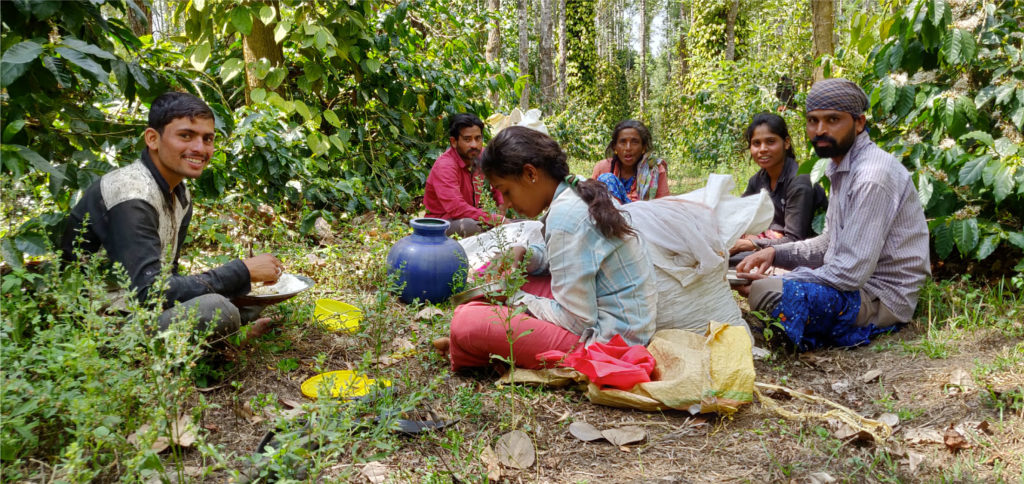
Coffee laborers having lunch on a coffee farm.
Iterating relevant service design and a weather service at scale
Commencing in May 2022, we will conduct multiple rounds of in-depth qualitative interviews with men and women coffee farmers. The sample will include farmers working a range of landholding sizes and will include both smartphone and feature-phone owners. The objective of the first set of interviews is to better understand how coffee farmers make decisions relating to the timing of agronomist-identified, weather-dependent coffee activities: fertilizer and lime application, coffee pruning, shade regulation, and harvesting. We hope to identify how weather fits into these decisions and what other factors influence the timing of these activities. If other limiting factors (such as the availability of an input) impact timing to a greater extent than the weather, forecast information with short lead times may not help farmers optimally time their practices without access to complementary inputs or information. These interviews will also help us identify how farmers interpret weather forecasts they already have access to, what impact incorrect forecasts have on their activities and on their trust in forecasts and the extent to which farmers discuss their expectations of upcoming weather with other members of their communities.
As detailed in previous blog posts about our weather-related work, PxD is partnering with leading private forecast provider CFAN (Climate Forecast Applications Network) to develop calibrated custom forecasts. Using weather forecasts from CFAN provides access to a continuous stream of information, which includes the numerical quantity of a rainfall event being forecast, numerical probabilities associated with a forecasted weather event, and error margins on the quantity of rainfall forecast for each of the upcoming 15 days3Read more about our collaboration in this previous blog post. Building on the first set of qualitative interviews, we plan to assess (1) whether farmers comprehend and have an appetite for probabilistic and uncertain information; (2) whether specific forecast attributes or lead times meaningfully change farmers’ expectations of upcoming weather; and (3) which combinations of attributes and lead times aid decision-making for each weather-dependent activity. We plan to gauge farmers’ understanding of probabilities and uncertainty in a second set of in-person interviews to whittle down the forecast formats that will be most useful in this context.
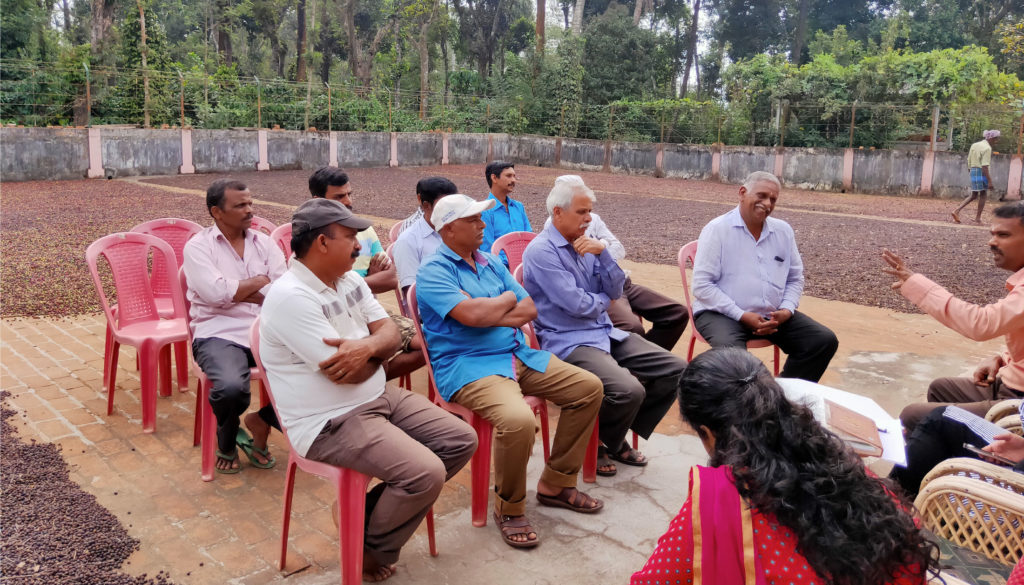
PxD facilitated Interviews with coffee growers.
Coffee farmers in a subset of villages in our three study districts will then be invited to participate in in-person workshops, where they will interact with different forecasting formats. The workshop will be in the form of a ‘lab-in-the-field experiment’, where participants engage with an interactive platform that presents weather forecasts together with incentivized agricultural decision-making scenarios. Utilizing participants’ decisions on the platform, an ‘in-scenario’ weather ‘realization’ will be simulated, allowing participants to accrue a higher payoff for a ‘better’ decision. The best-performing forecast will accrue the highest cumulative payoff across participants and will inform our understanding of which forecast formats most effectively aid decision-making. The ‘best-performing’ customized-to-context weather forecast will then be piloted in the field among a sample of existing CKT users to evaluate whether it improves decision-making in a real-world setting.
Delivering an effective weather-based advisory service via mobile phone also requires that we ensure that users engage with and use the information being delivered. To this end, we plan to run A/B tests to optimize the frequency with which weather forecasts are delivered, the length of messages, and other service features.
We are optimistic about the utility of weather forecasting information and its potential impact on smallholder farmers — and their productivity — as they make what we hope will be more informed decisions. We are excited to deploy this information and make it actionable for smallholder coffee producers on our CKT service. Watch this space!

Precision Development (PxD) has completed a landscape analysis to more systematically understand the challenges faced by users of the Coffee Krishi Taranga (CKT) service, with a focus on three core areas, namely, sustainability, market linkages, and gender. This work was funded by a grant from the Walmart Foundation.
As part of the landscape analysis, we conducted multiple rounds of farmer interviews, an extensive review of the literature, an analysis of our existing farmer database, and interviews with sectoral experts. In this blog, we share some key findings and information about what we’re looking to do next.
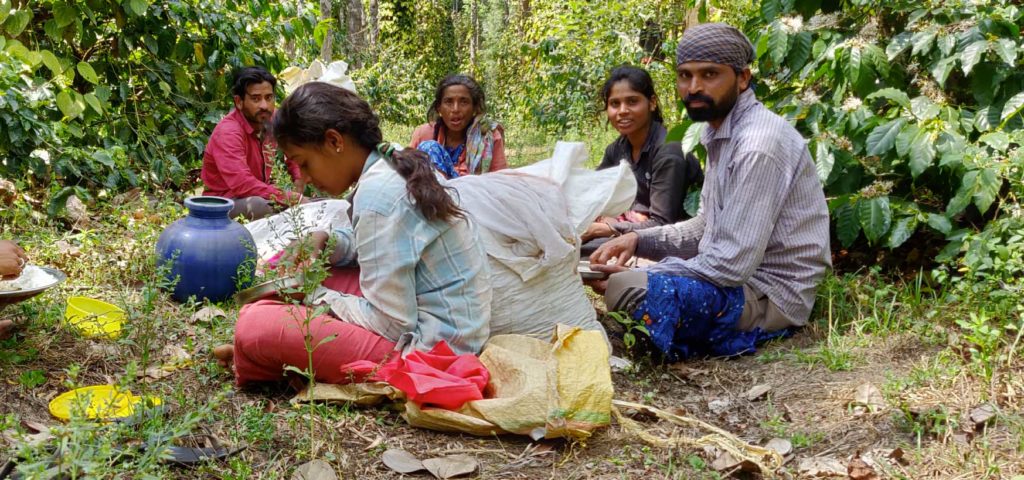
Coffee Krishi Taranga
Since August 2018, PxD has partnered with the Coffee Board of India to provide the CKT service to coffee growers. The CKT service is modeled on PxD’s flagship two-way Interactive Voice Response (IVR) service, which comprises an outgoing service that provides regular advisory to growers on their mobile phones and an inbound hotline that farmers can call to access free information services, including market-related information, and leave messages to be answered by agronomists. As of April 2022, the CKT services approximately 74,000 coffee growers across the states of Karnataka, Tamil Nadu, and Kerala. The team plans to expand the reach of the service to growers in Andhra Pradesh soon.
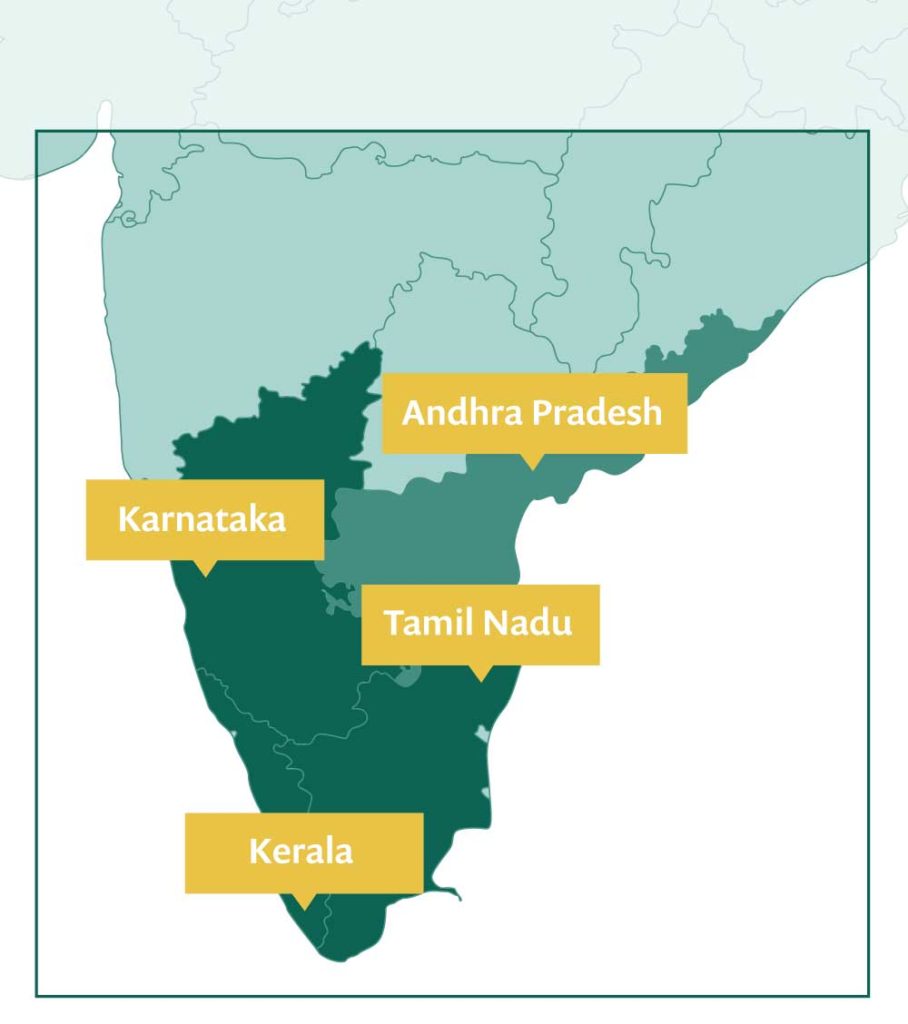
Key findings
Sustainability
Coffee growers in India face multiple risks linked to weather unpredictability, a challenge that has been exacerbated by climate change. Coffee is a sensitive crop, and heat and rainfall are widely considered to be the two most important factors for coffee growth1Haggar, J. and Schepp, K. (2012). Coffee and Climate Change Impacts and options for adaptation in Brazil, Guatemala, Tanzania and Vietnam. National Resources Institute Working Paper Series: Climate Change, Agriculture and Natural Resources, [online] No. 4, pp.1–50. Available at: https://www.nri.org/publications/working-paper-series/4-coffee-and-climate-change/file [Accessed 14 Sep. 2021].. In farmer interviews conducted in September 2021, 92% of farmers (N=83) said they had faced a weather-related challenge in the past year2Haggar, J. and Schepp, K. (2012). Coffee and Climate Change Impacts and options for adaptation in Brazil, Guatemala, Tanzania and Vietnam. National Resources Institute Working Paper Series: Climate Change, Agriculture and Natural Resources, [online] No. 4, pp.1–50. Available at: https://www.nri.org/publications/working-paper-series/4-coffee-and-climate-change/file [Accessed 14 Sep. 2021].. Weather can negatively impact the cultivation of coffee in a variety of ways, including crop damage at sensitive times such as blooming3Pokiya, T. (2021). Interview: Agronomist, PxD. 16 Jun. , increased incidence of pests and disease, increased soil erosion, and more.
What are we doing?
One obvious solution to mitigate the risks of weather variability is weather forecasts, in particular providing customized weather forecasts or real-time weather information, potentially coupled with relevant agronomic recommendations. However, access to high-quality forecasts is limited. In our farmer interviews, only 16% (N=73) said they have access to forecasts4 Krishi Taranga coffee growers (2021). Qualitative farmer surveys: Round 5. 24 Sep.. Our team is currently in the process of putting together a pilot to test the impact of providing customized weather forecasts on key agricultural practices (if you’re interested in learning more about PxD’s weather-related learnings, check out this recent series of blogs).
“The weather imbalance leads to severe black rot and we cannot use spray at the right time.”
Interview with D.S. Sathish, Basrikatte, Chikmagalur
The increase in average temperature and erratic rainfall also exacerbates risks associated with certain pests5 Watts, C. (2016). A Brewing Storm: The climate change risks to coffee. [online] The Climate Institute, pp.1–14. Available at: https://www.juntospelaagua.com.br/wp-content/uploads/2016/09/Pesquisa-sobre-caf—The-Climate-Institute.pdf [Accessed 14 Sep. 2021].. The impact of climate change on pests varies, but overall heavy rain and warmer temperatures are likely to increase the conditions in which several pests thrive. These pests can cause varying levels of damage — some can be devastating, resulting in crop losses of up to 70% if not treated timeously and effectively.6Machenahalli, S., Ranjini, A. P., Madhu S., Giri, Sudha M., Daivasikamani, S. and Surya Prakash Rao N. (2019). Disease of Coffee during monsoon season and their management. [online] Planter’s World, May, pp.4–7. Available at: https://krishi.icar.gov.in/jspui/bitstream/123456789/23682/1/coffee%20disease%20during%20monsoon.pdf [Accessed 14 Sep. 2021].
To explore ways to provide more targeted and actionable recommendations for pest management, we ran an A/B test in November 2021 that looked at the impact of sending multiple reminders on farmers’ knowledge and adoption of high impact practices. We focused on the treatment of white stem borer, an increasingly common pest for coffee growers in India. The results from this test will be shared shortly!
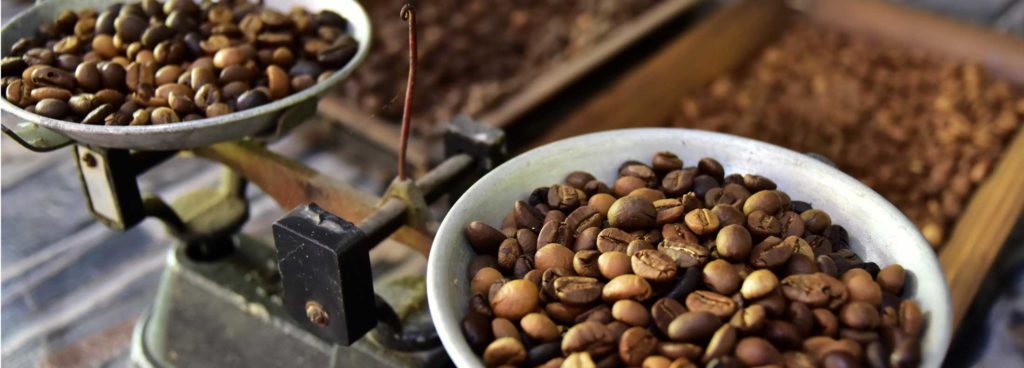
Markets
Smallholder coffee growers sell their produce in fragmented and exploitative local markets. A survey from Chikmagalur and Hassan districts (Karnataka) found that over 90% of growers sold their produce at the farm gate7 Babu, P. (2019). Value Chain Upgrading Strategies for Integration of Indian Small Coffee Growers in Global Coffee Value Chain. Economic Affairs, 64(4).. In our interviews, we found approximately 50% of farmers (N=140) sell their coffee to local traders or markets8Krishi Taranga coffee growers (2021). Qualitative farmer surveys: Round 1. 6 Jul.. There are several reasons why these selling conditions are less than ideal. This includes a lack of infrastructure: smallholders, who deal with relatively small amounts of coffee, usually sell directly to a local trader or agent who pays them on the spot and bears the costs of transporting the coffee to the curing agent. This is where smallholders often lose value on their coffee as local traders set the price for the farmers’ produce.
Another concern is high price variability and lack of transparency. Local traders set coffee prices according to international coffee trends. When buying from farmers on the ground, this price is adjusted based on the quality of the product, which is measured by moisture and out-turn tests. However, the degree to which prices are adjusted based on these metrics is not always clear, leaving farmers feeling frustrated.
“Traders will not buy coffee at existing coffee prices. When traders provide information about prices [they say] it will be more, but [when it comes to] selling the coffee, traders fix a certain [lower] rate and give the unnecessary reason that the moisture content is not good.”
Interview with A.G Nannaiah, Virajpete, near Madikeri
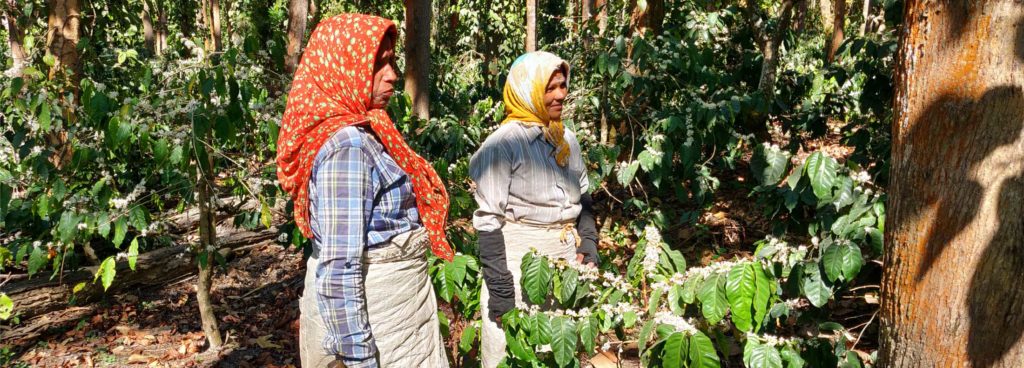
What are we doing?
As part of the CKT hotline, we offer a free price feature which farmers access to listen to daily local and international price information. This is our most used feature, indicating interest in price information. However, overall usage of the hotline is low. We are currently exploring alternative ways of delivering price information to our farmer base, in the hope of reducing frictions and increasing the use of market price tools and information. Lines of relevant inquiry include exploring the use of WhatsApp and SMS to provide price alerts.
To explore ways of reducing price variability, which contributes to income volatility and uncertainty, the PxD team is running a market linkages pilot with the Sustainable Trade Initiative (IDH) in Karnataka. IDH will facilitate contracts between interested buyers and smallholder growers, in which buyers commit to purchasing produce (granted it meets certain quality conditions) at a fixed price. PxD will support growers in meeting these conditions by disseminating relevant agricultural information.
Gender
“My wife visits the estate whenever it is necessary, for example if I am away from the station she looks after things, and after the harvest and the coffee is dried, she weighs it and keeps a record of the quantity of coffee available after it has dried.”
Interview with Virajpete Madhayya, Madikeri
As per India’s Census 2011, coffee plantations were major employers of women workers in Karnataka; out of a total of 480,000 average daily workers employed in coffee plantations, 62% were women. Women appear to be employed for specific activities such as coffee picking, weed management, and applying manure and chemical fertilizers 9Joy, C.V. (2004). Small Coffee Growers of Sulthan Bathery, Wayanad Kerala Research Programme on Local Level Development Centre for Development Studies Thiruvananthapuram. [online] Centre for Development Studies, Kerala, India: Centre for Development Studies, pp.1–43. Available at: http://www.cds.ac.in/krpcds/publication/downloads/83.pdf [Accessed 29 Oct. 2021].. In our interviews with women, we found that women are heavily involved in specific coffee-related activities, including weeding and coffee picking. While women are generally not primary decision-makers for most activities, they appear to be included in the decision-making process. We also learned that women are often part of community groups including self-help groups like “Swasahaya Sangha” (for more information, see our blog post on women’s groups).
What are we doing?
We would like to explore the role of women’s groups and whether these can be leveraged to increase engagement with, and provide relevant support to, female farmers. Evidence from our other programs and the literature suggests that women can increase their collective knowledge and engagement through participating in community groups. The fact that many women in our service are generally involved in day-to-day decision-making suggests that there is room to cater specifically to the areas in which women work. This includes exploring value chains adjacent to coffee cultivation where women may have more involvement, for example, intercrops like spices.
Looking forward
The landscape analysis helped our team gain a broader understanding of the range of challenges and opportunities that exist within the coffee sector in Southern India. In doing so, we have been able to strategize and set evidence-based priorities. This includes focusing on addressing weather-related risks through a pilot to test the impact of providing customized weather forecasts to coffee growers, and a market-focused pilot with IDH.
At the same time, we are also scaling our program with the support of the Walmart Foundation. This includes expanding to another coffee-growing state, Andhra Pradesh. Coffee growers in Andhra Pradesh are different from those in Karnataka, as they are primarily based in tribal regions and practice more traditional farming. We are excited to learn more about coffee growers in this region and adapt our existing service to address their unique information needs.

PxD is building a free weather forecast product for cotton farmers in Pakistan’s Punjab Province to be launched in March, ahead of Kharif – South Asia’s summer planting season. The service will be launched in phases and will ultimately serve 490,000 smallholder cotton farmers across the province.

We are excited by the pioneering potential of this product for distributing weather information to inform decision-making on the part of poor, rural farmers in Pakistan’s cotton belt. Moreover, we have been excited to engage in an intentional process of product design from which we have learned a great deal, and which we anticipate will inform the further iteration and development of weather programming and forecast provision across PxD’s geographies, and beyond.
As we have iterated this new product, we have grappled with wide-ranging design possibilities that could increase usefulness and impact. Guiding questions include: Is it more valuable for farmers to receive good weather information – as is typically offered – or is it more valuable to complement forecast information with digital agronomic recommendations (a core PxD competence)? During what stages of the crop cycle, and for which key decision-points, is weather advisory most valued and impactful? At what frequency should advisory be given? How does one communicate probabilities in a way that is accessible and practical for farmers? How does a farmers’ relationship with the weather – and informational needs – differ based on whether their crops are irrigated or rain-fed?
To guide more informed product design decisions, in November the Pakistan team commenced with a set of end-user interviews with 55 cotton and wheat farmers. While 71% of wheat farmers cited access to weather forecasting information, only 45% of cotton farmers surveyed reported access to weather information. When asked if weather information “helped in planning”, 88 and 86% of cotton and wheat respondents respectively responded in the affirmative. This finding buttresses an earlier survey of wheat farmers users in Pakistan where, in response to the question “What agriculture-related information do you need for your wheat crop during the next month?”, 18.5% of respondents cited weather. When canvassing end-users in November, farmer users were asked to “Please list the types of weather challenges you have experienced” in the three years prior to being surveyed. Forty-three percent of respondents who reported experiencing weather-related challenges cited heavy rainfall and 30% reported high winds.
These types of weather incidents can be very costly for smallholder farmers with limited resources. Inundation washes away expensive inputs, creates mud that blocks sprouting crops, and creates conditions conducive to disease, while wind can destroy or severely damage crops throughout the cropping cycle. Further, when prompted to answer “Out of these weather challenges, which three have the largest impact on your crop costs and yields”, pest management was reported as the most common answer. Many pests and diseases thrive in particular weather conditions and can proliferate quickly if conditions are optimal. This suggests that a combination of advisory and weather forecasting information alerting farmers to be on the lookout for pests and to initiate pesticide application decisions sooner could be valuable as a means for reducing pest damage.
To test certain features of our Kharif forecasting products in practice, the PxD Pakistan team took advantage of the ongoing Rabi wheat season (winter planting cycle) to launch two minimum viable products (MVPs) as an AB test. This round of product development was delivered to roughly 2,000 wheat farmers, with each pilot product servicing approximately 1,000 farmers, respectively. The first treatment entailed a simple 48-hour weather-only forecast delivered via SMS and robocall. The second treatment issued an equivalent 48-hour weather forecast to 1,500 wheat farmers, complemented by recommendations on how to adjust one’s irrigation accordingly.
In February, when users have been exposed to the MVP services for two months, they will be surveyed to obtain richer feedback. This survey will aim to answer the fundamental question about whether farmers value weather-linked advisory over weather-only messages. If weather-only is the clear preference, this may suggest that farmers are generally able to connect actions to relevant weather. In the event that farmers do not explicitly need advisory as a complement to forecasting information, this would greatly simplify product development. Secondary questions source farmers’ views on the frequency and relevance of distributed messages. Lastly, under the hypothesis that farmers will prefer advisory linked to weather information, in-field focus groups will be conducted in March to expose farmers to an array of pre-recorded agronomic recommendations and message framings. Feedback from farmers will be used to inform the iteration of advisory scripts and message framing as we work to maximize comprehension, particularly relating to the communication of uncertainties and probabilities, and address potential barriers to adoption.
Another core challenge in developing this product is the quality of the weather forecasts themselves. The existing forecast services in Punjab tend not to be designed with the end user’s needs in mind. Three services in Punjab, Pakistan exemplify usability issues: the first requires user-initiated, user-paid inbound calls; the second requires internet access; and the third is only available to subscribers of a particular telecoms company.
To overcome these types of challenges, PxD is partnering with the private forecast provider CFAN (Climate Forecast Applications Network) to develop calibrated custom forecasts. CFAN is a leading forecast provider, with temperature, cyclone, and severe weather products across North America, Central America, and Asia, and extensive experience in forecasting South Asia weather dynamics. In addition to giving PxD the flexibility to adapt CFAN’s data streams according to our users’ needs, we are using this partnership to transparently assess the magnitude of upfront costs required to build a forecast system.
Learnings from these research activities, coupled with insights generated by our collaboration with CFAN, will inform the final design of our Kharif weather forecasting product for cotton farmers. Once this product is up and running, the focus will shift to impact evaluation, including pick-up rates, behavior changes, and forecast accuracy. Pending a review of such impact outcomes, and funding considerations, the product will be further developed to cover the Rabi season and potentially scaled to additional countries.
This Kharif season, we are thrilled at the prospect of hundreds of thousands of Punjabi smallholder cotton farmers witnessing less fertilizer – and by implication, fewer resources – washed away or harvests inundated by unexpected rains, deploying more effective irrigation tailored to the forecast, and incurring fewer crop losses due to heavy rains and winds. When we asked our PxD Pakistan agronomist about the potential impact of this product, she said: “This product will reduce farming risks and expenses, and increase what is usually a farmer’s sole source of income – allowing for more investment into farming or money for personal expenses”. We are also excited about the potential for this product to serve as a template for iterative product and design process management, and proof of concept, which others may learn from and implement in other settings.
Mark Tamming is an Associate in the London Office of Oliver Wyman, a management consulting firm. Oliver Wyman generously sponsored Mark in joining PxD as an ‘extern’ for three months on PxD’s product team. Shams Sadiq is a Research Associate on the PxD Pakistan team. We thank Khushbakht Jamal, Mahroz Haider, Jagori Chatterjee, Fatima Fida, Adeel Shafqat, Omer Qasim, Hannah Timmis, and the broader PxD Pakistan team who offered valuable contributions to this post and the product development that sits behind it.
Accurate weather forecasts would reduce uncertainty for farmers, yet they are under-supplied and under-studied in developing countries. Government and market failures reduce the quality and reach of weather information in rural regions, reducing its value for households. To address these gaps, Precision Development (PxD) is piloting the provision of improved forecasts to farmers in India and Pakistan. The pilot will investigate how farmers interpret and use weather information, including the cognitive and informational barriers that constrain adoption.

The costs of weather uncertainty
Smallholder farmers live with copious amounts of risk, leaving them vulnerable to income variability and losses. Weather uncertainty is a major source of this risk. A survey of farmers in poor, southern districts of India, for example, found that 73% of respondents had abandoned their crop at least once, in the ten years prior to being surveyed, after misjudging the onset of the monsoon; and one quarter had replanted (Giné et al., 2015). These activities are costly: the authors rank farmers by the accuracy of their monsoon predictions and show that the gross agricultural income of those in the 25th percentile is 8-9% lower than those in the 75th percentile. Other research documents how farmers respond to weather uncertainty by reducing investments in technologies or complementary inputs, which lowers their average profits (Zimmerman and Carter, 2003; Rosenzweig and Binswanger, 1993).
Because weather variability can be disastrous for poor households and is increasing with climate change, economists have dedicated much attention to products that mitigate its consequences, including index insurance and climate-resilient crop varieties. While effective in increasing farmers’ investments and profits, many of these innovations incur high distribution costs that limit their scalability (Cole & Xiong, 2017). PxD is therefore exploring an alternative solution for farmers that face increasing climate risk: accurate, phone-based weather forecasts.
Forecasts have a high potential for cost-effectiveness and scale. By reducing uncertainty over future conditions, they allow farmers to make better production decisions throughout the season. Long-range forecasts of conditions over one to three months can enable farmers to make more informed decisions about how much to invest or which crops to grow, while shorter-range products can be used to determine the best time to conduct activities like fertilizer application. These decisions have the potential to generate meaningful yield impacts; PxD’s agronomy team in India estimates that transplanting rice seedlings from the nursery to the field at the right time can generate yield increases of up to 10%, relative to transplanting too late. Moreover, the marginal cost of delivering phone-based forecasts is low relative to other products that reduce risk, meaning that the returns to their provision would increase with scale.
Currently, however, rigorous evidence on weather forecasts’ effects on farmer outcomes is sparse. Part of the reason may be the limited availability of accurate, useful forecasts in many developing countries. Producing high-quality weather predictions is costly and complex: state-of-the-art observation infrastructure, rapid data transmission systems, high-performance computing, and specialist staff are all required (Rogers et al., 2019). Cash-strapped public providers often lack this capacity, while the private sector has few incentives to serve poor consumers. As a result, the forecasts that smallholders can access are typically well behind the technology frontier.
The limited evidence base suggests that these quality shortfalls reduce forecasts’ value for farmers. For example, an observational study in India found that state-provided seasonal forecasts do increase agricultural profits, but only in the few areas where forecasts happen to be accurate (Rosenzweig and Udry, 2019). Additionally, in Ghana, preliminary results from an experimental evaluation of 48-hour, SMS-based forecasts, found effects on farmer behavior but not on profits (Fosu et al., 2018). Short lead times and a lack of complimentary advice may explain the lack of impact: a review of farmer-focused forecasts in developed countries finds that these factors reduce take-up and usefulness (Mase and Prokopy, 2014).
Unlocking the potential of weather forecasts
PxD’s new pilot aims to build the evidence on the benefits of improved forecasts for smallholders. We have partnered with the Climate Forecast Applications Network (CFAN), a private provider with expertise in developing innovative weather information tools in South Asia, to deliver hyper-local forecasts and related advisory to smallholders in India and Pakistan. CFAN’s products are anticipated to improve on existing forecasts in the region in terms of accuracy, lead times, and precision. Importantly, they can also be calibrated to predict weather phenomena that are particularly relevant for agricultural decision-making, such as prolonged dry spells suitable for fertilizer application or monsoon onset dates.
PxD’s pilot activities will test the efficacy of different intervention designs in both contexts, laying the groundwork for a large-scale randomized evaluation of weather forecasts’ effects on agricultural outcomes that we hope to implement in 2023. Some of the questions we will explore during this preliminary phase include:
- To what extent do farmers update their subjective weather expectations in response to different forecasts? What role do informational, cognitive, trust or other barriers play?
- How do farmers interpret probabilistic weather information? Do forecasts with a numeric probability of a weather event and a qualitative likelihood of the same event affect their beliefs differently?
- For which agricultural decisions could improved forecasts generate the greatest returns?
- Does improved weather information spread among farmers within and across villages?
The findings of the pilot and subsequent evaluation will have policy implications at PxD and beyond. For example, improved understanding of the returns to information products that reduce agricultural risk will inform PxD’s prioritization of new services, such as pest prediction models. The project will also seek to provide policymakers with evidence and incentives to increase funding to improve forecasts in regions that are under-served by governments and markets.
Many thanks to Sam Carter, Jonathan Faull and Yifan Powers for their excellent comments and suggestions on an earlier iteration of this post
Last week delegates convened in Glasgow at the 26th Conference of the Parties (COP26) to the United Nations Framework Convention on Climate Change to engage in the difficult task of negotiating an offramp to climate catastrophe. The vast majority of PxD’s 5.2 million users are poor farmers who confront myriad – and reinforcing – challenges linked to climate change, food security, and poverty. We are excited to have secured new funding to pursue research opportunities for climate mitigation innovations to benefit smallholder farmers.
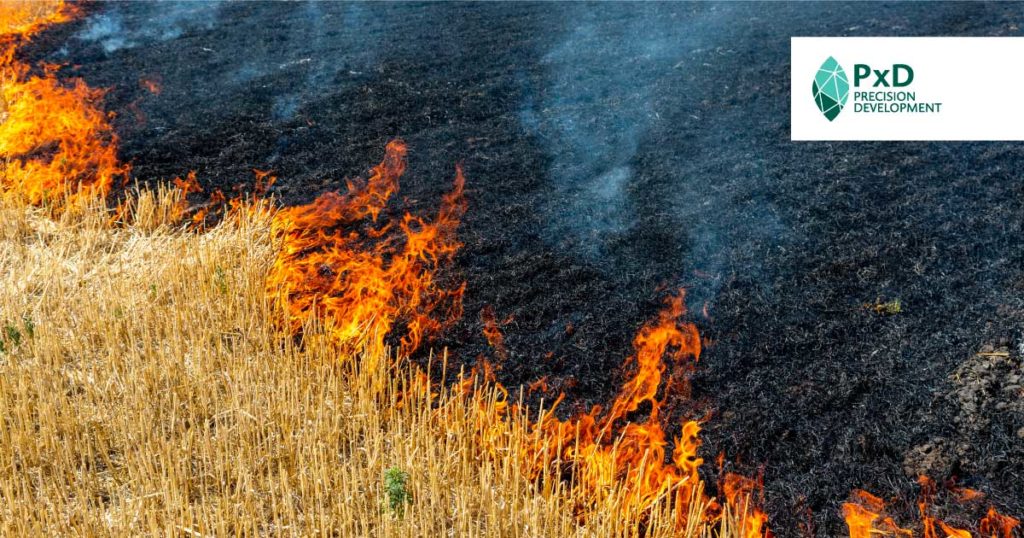
In this post Dina Rodrigues, Global Research Support Associate, Caitlin McKee, Assistant Director of Research, and Tomoko Harigaya, Chief Economist and Director of Research, present how PxD thinks about the complementarity of research, service design, service delivery, the evaluation of impact, and development practice. We assess how our programming can promote behavior change to advance climate-related goals, and we lay out opportunities for new research.
As we work to enhance our service offerings and research activities, to identify new opportunities for climate innovation, and to assist our users to lead more productive and resilient lives, we are guided by the following principles:
- User benefit first – Smallholder farmers cannot be expected to pay the price for climate mitigation. All climate-friendly advice to smallholder farmers from PxD should support livelihoods and not compromise agricultural yields or smallholders’ income. If there are evidence gaps on farmer benefit, we will explore ways for farmers to be favorably compensated for adopting those practices as an additional source of income.
- Adapt and mitigate – Our ambition is to promote both climate change adaptation (reducing potential damage) and mitigation (tackling the causes) activities.
- Replicate and scale – To fully leverage the advantages of scale, we work to ensure that our advisory services can be replicated across multiple contexts and with a diversity of partners.
The role of research at PxD
PxD’s systems are designed to scale the delivery of customized digital information to individuals and households so that they can act on it to improve their well-being and reduce exposure to risks and disasters such as floods and droughts. Our systems are designed to be scaled; as they scale, average costs fall and we improve the cost-effectiveness of our delivery.
Research is integral to this work. We deploy experiments and other research methods to inform the design of our services (innovation research) and to evaluate our impact (evaluation research). We generate evidence and insights based on a range of activities, from large randomized controlled trials to small-scale pilots. We learn from experiments that show statistically significant results and null experimental results, as well as through the analysis of descriptive and qualitative data.
PxD’s goal is to generate large aggregate impacts for the poor, and the role of research at PxD is to draw insights from empirical data, existing evidence, scientific knowledge, and theories to:
- Contribute to the development of PxD by identifying impact opportunities through the generation of insights into technological change, partnerships, scenario planning, and strategic choice, etc.
- Inform the design of programs and PxD’s investment decisions.
- Rigorously test and iterate ideas and assumptions.
- Evaluate and quantify the impact of our programs.
- Increase our understanding of the link between what we can observe and the ultimate outcomes we care about.
- Contribute to a broader knowledge base for practitioners, policymakers, and researchers.
In this way, our researchers support and collaborate with teams across the organization to enable efficient and effective learning through rigorous research to advance PxD’s goals.
Meeting the challenge of the age
We are intensifying our efforts to provide information to smallholder farmers that will allow them to make informed decisions to reduce the risks that climate change presents to their livelihoods and to enjoin their farming and land management activities in the fight against climate change. PxD is focusing on identifying interventions that can improve smallholder livelihoods whilst incorporating climate adaptation and mitigation efforts into our existing services. A key component of this is identifying feasible methods for measuring outcomes and program impacts on farmer welfare and the climate. A further component of our research agenda is to iteratively develop, refine, and test these innovations at scale.
Climate-smart advisory, adaptation, and mitigation efforts are already embedded into our programs across all the geographies we work in, as well as into the day-to-day agricultural activities that PxD farmers carry out. We focus both on climate change adaptation (reducing potential damage) and climate change mitigation (tackling the causes), as the activities and approaches are distinct.
1. Climate Change Adaptation
Adaptation efforts focus on anticipating the adverse effects of climate change and taking appropriate action to minimize potential damage for those most likely to be adversely affected, whilst managing and, hopefully, reducing climate-related risks. Ultimately, the aim of climate adaptation is to enhance the resilience of the individuals, households, and communities most vulnerable to negative climate shocks. These efforts generally involve the use of dynamic, local information to adapt their practices to climate shocks and behavior change and the adoption of new technology to increase resilience. At PxD we are increasingly asking questions such as: How climate-vulnerable are the farmers that use our services; What are the consequences of climate change that are affecting smallholder farmers’ lives; And how can we reduce the welfare loss that individual farmers and communities experience, or are likely to experience, because of climate change?
Weather uncertainty is one of the biggest agricultural risks faced by smallholder farmers. Climate change has increased weather variability and unpredictability in many parts of the world, imposing greater risks on agricultural production. These challenges are exacerbated by a lack of appropriate infrastructure and insufficient ground validation to provide accurate weather forecasts in many parts of the Global South.
PxD programs include adaptation efforts to reduce weather-related risk and uncertainty caused by climate change. One such example is the promotion of flood-tolerant seeds in the state of Odisha, India, on PxD’s largest Indian service, Ama Krushi, which currently has over one million users. Two-thirds of Ama Krushi farmers have experienced significant crop damage due to weather shocks and, of these, 57% experienced flooding. PxD’s climate adaptation efforts included experimentation with simplified, targeted Interactive Voice Response (IVR) messages to nudge the adoption of flood-tolerant rice varieties. We found that our simplified low-cost messaging significantly increased low and medium land types farmers’ adoption of flood-tolerant seeds. On average, these farmers were 2.6 percentage points more likely to plant flood-resilient seeds after receiving a message, a 25% increase over the control group mean adoption rate of 10.4%.
In another geographic context, in Punjab, Pakistan, PxD is working on new product design to further customize our advisory by integrating granular weather data into existing services. PxD will use enhanced weather models to inform farmers of local conditions, linking weather conditions to relevant agricultural advisory. Existing forecasts in Pakistan mainly lack both the granularity and the accessibility to meet the needs of smallholder farmers and support day-to-day farming decisions. Via partnership with experts in satellite-based weather prediction models, PxD will develop a granular forecast at the local tehsil level, and PxD will leverage its communication for behavior change expertise, disseminating this information via SMS and voice. In addition, we are conducting user research and consulting agronomists to design and test agricultural advisory that is linked to weather forecasts.
Finally, when weather calamities are anticipated, many PxD services advise farmers on what they can do to minimize crop damage. In Odisha and West Bengal, for example, our services inform farmers of impending cyclones, advise them about actions they can take to protect their crops in the field, or encourage them to bring in their produce from the field early, if appropriate. Our advisory can also promote appropriate post-harvest and storage practices in contexts where a farmer may otherwise not have expected to take action.
Example of paddy/rice crop advisory for deficit rainfall
English Translation:
Namaskar. Welcome to the ‘Ama Krushi’ free Agriculture Information service of Department of Agriculture, Government of Odisha. Paddy crop is affected by current scanty rainfall situation in many districts of Odisha. Today we will give some advisory to manage paddy crop due to scanty rainfall situation. Do not practice Beushaning in rice, if the crop is more than 45 days old. Don’t wait for rainfall and carry out hand weeding. In line direct sown paddy, use manual weeder if optimum soil moisture is present. Don’t go for Beushaning in areas where large deficit of rainfall has been seen. Go for hand weeding and gap filling using seedling of same age or clonal tillers to have a uniform distribution of plant after optimum rainfall is received. If basal fertilizer is not applied in direct sown paddy than apply 38-kg of DAP/acre, 20-kg of Urea/acre, 14-kg of MOP/acre., 4-kg of Borax/acre and 10-kg of Zinc Sulphate/acre. Strengthen the field bunds and close the holes to check seepage loss. For delayed transplanting seedlings up to 45 and 60-70 days old can be transplanted in case of medium and late duration rice varieties, respectively without much reduction in yield. Transplant the old seedling in puddled soil at shallow depth with closer spacing of 15 x15 cm and 4-5 seedlings per hill. Apply 50 % Nitrogen fertilizer along with other recommended fertilizer during transplanting. Thank You.
Example of paddy/rice crop advisory for excess rainfall
English Translation:
Namaskar. Welcome to the ‘Ama Krushi’ free Agriculture Information service of Department of Agriculture, Government of Odisha. Today we will discuss about some crop management strategies after excess rainfall due to low pressure and depression in Bay of Bengal. Drain out excess water from paddy field if possible. If the paddy crop is under submergence temporarily, apply 10-12 kg of MOP after rainwater recedes. Don’t apply fertilizer and wait for new tillers to come if paddy crop is affected largely due to complete submergence. If crop is lodged due to excess rain and wind, then try to keep it upright by binding few hills. There are chances of increase in chaffy grains if the crop is in panicle emergence stage. To minimize chaffy grains in the panicle spray Boron 20 % (Folibor/Solubor) @ 1-1.5 gram/litre or Borax @ 2-2.5 gram/litre of water. Spray fertilizers or pesticides during afternoon hours instead of morning hours if the crop is in flowering stage. Thank You.
2. Climate Change Mitigation
Mitigation efforts focus on tackling the causes of climate change to reduce the flow of heat-trapping greenhouse gases (GHG) and other climate and air pollutants, like black carbon soot, into the atmosphere. This can be achieved either by reducing emissions of climate pollutants or by increasing carbon sequestration in the soil, forests, and oceans. When it comes to smallholder farmers, climate mitigation focuses on changes in agricultural and land management practices and the adoption of new technologies or farming behaviors that can contribute to reducing emissions or increasing sequestration at scale. At PxD, we are increasingly preoccupied with ensuring that such behavior changes are also beneficial for the individual farmers and communities we serve.
Some agricultural practices are likely to contribute both to poverty alleviation and climate mitigation if they result in increases in agricultural outputs or income. One such example is promoting the optimal and timely application of nitrogen-based fertilizers. Most PxD advisory services, across our various geographies, include recommendations on the optimal application of planting and/or top-down fertilizer. Our agronomy teams have identified overuse of nitrogen fertilization and underuse of other required fertilizers with smallholders who tend to rice paddies and cotton fields in the Indian states of Odisha and Gujarat, respectively. Whilst nitrogen fertilization is an important component of crop production, crops can only efficiently absorb a finite amount of nitrogen. Nitrogen applied in excess contributes to water and atmospheric pollution in the form of nitrates or nitrous oxide. Emissions tend to be proportional to the amount of fertilizer used and the concentration of nitrogen in the product. Precise application of nitrogen fertilizers has the potential to cut down farming costs if farmers need to purchase less fertilizer, hence improving smallholders’ agricultural income whilst curbing nitrous oxide emissions. We are exploring user-friendly tools, such as leaf color charts, to support farmers to optimize their fertilizer application.
In addition, several of our services in Africa, including MoA-Info in Kenya, push-calls in Nigeria, and UCAT-Uganda, advise farmers to cover crops to slow erosion, improve soil moisture, and prevent pests and disease outbreaks. PxD farmers across most of our geographies also control soil erosion via techniques such as terracing or contour plowing. These methods are likely to improve yields via a general enhancement of soil conditions whilst increasing soil propensity for carbon sequestration by slowing erosion.
However, some agricultural practices have unclear effects on yields, agricultural income, or climate outcomes. Most worryingly, many behavior changes that present opportunities for climate mitigation put a burden on smallholder farmers. In these cases, decision-makers, researchers, and practitioners must identify ways to compensate farmers for the social benefits they generate by adopting those behavior changes, whilst guaranteeing an immediate private return for early adopters. This may include payment schemes, such as conditional cash transfers, or subsidies for improved technologies, but further research is needed to understand what kind of incentives and measurement techniques are likely to work in various settings.
Opportunities for new research
In partnership with the Institute for Governance & Sustainable Development (IGSD), PxD will undertake exploratory activities with a specific focus on climate change mitigation in addition to poverty alleviation. We are excited to scope our existing programs and partnerships to identify:
- Opportunities for scalable climate mitigation innovations.
- Evidence and measurement gaps.
- How we can leverage soil science, remote sensing, and soil sensor technology to improve agricultural productivity and generate climate mitigation innovations.
- Barriers and opportunities in terms of measurement, adoption, and smallholder behavior change.
The aim of this work is to lay a foundation to ultimately develop, test, and scale innovations such as payment schemes or cash-transfer approaches that can simultaneously address climate change and reduce poverty.
On a preliminary basis, we have identified the following potential climate mitigation areas:
- Reducing black carbon emissions from crop or biomass burning
- Reducing nitrous oxide emissions from fertilizer overuse
- Enhancing soil carbon sequestration
- Protecting and enhancing carbon sinks through forestry
- Reducing methane emissions from livestock, dairy, and rice.
Within each of these areas, PxD plans to scope relevant agricultural activities practiced by farmers engaged with our advisory services across all our geographies, relevant partner capabilities, and potential external consultants. Based on this mapping exercise, we aim to identify specific technologies and farming practices that can improve climate mitigation outcomes at scale in conjunction with relevant measurement outcomes (e.g., soil carbon, soil characteristics, and GHG and climate pollutant emissions reductions).
PxD is committed to always putting the welfare of smallholders and our contribution to poverty alleviation first. As an organization that works with over five million users across a variety of settings, PxD is well-placed to advance the knowledge frontier through rigorous experimental applied research. Our aim is to enhance the resiliency of smallholder farming households through the diffusion of information to promote the adoption of new technologies and climate-smart agricultural practices. We are excited to implement this nascent research agenda and enjoin the activities of millions of smallholders as agents of change in plotting a more resilient future.
We will share our learnings in future posts!

Make an Impact Today

